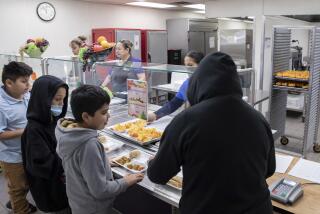School programs don’t get kids to eat many more veggies, study says
School-based efforts to get kids to eat more fruits and vegetables are not failing, but they’re no wild success either, according to an analysis of programs involving almost 26,400 children.
The kids ate a quarter portion more a day of produce – and if you just looked at vegetables alone, the increase was just under a tenth of a portion, according to the analysis of 27 programs published in the October issue of the American Journal of Clinical Nutrition.
So one sweet potato, or one cup of broccoli, would represent the increase for about 10 kids.
When juice was included as a fruit, the total went up to a third of a portion.
The research, by Charlotte E.L. Evans and colleagues at the University of Leeds in Britain, looked at programs in several countries. They also looked at two styles of intervention, and they found that how schools tried to get kids to eat more produce made a difference.
In what they called single-component programs, kids were given free or subsidized produce. In multi-component programs, such things as nutrition education and communication with families were included. The latter worked better, the researchers said.
The researchers noted that a previous study showing a 0.4-portion increase included mainly multi-component programs and did not break out juice.
Not only is it important for children to eat fruits and vegetables, their childhood habits carry into adulthood, the researchers wrote. Surveys report that U.S., European and Australian children eat two to three portions of produce a day – well below the five portions many government agencies recommend.
There’s plenty of work ahead, the study noted.
A couple of ideas that appear to work were exposing children to vegetables for 14 days, which “has been reported to increase liking and the consumption of vegetables.” And school garden programs have been shown to increase consumption of produce, the study said.
Mary.MacVean@latimes.com
@mmacvean on Twitter







